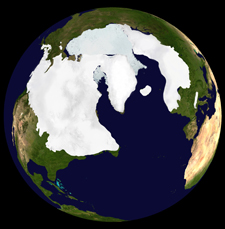What caused the end of the ice age?
Hi Ice and Climate researchers
I have seen the interesting news concerning the quick “push one button” end of the last ice age and it lead me to the following question:
- What caused the end of the ice age and what caused it to happen so quickly?
- Can one at least conclude that it was not manmade “greenhouse gas” emissions and if not, then what was it?
It could be interesting to hear an explanation for this – not the least with the current consensus over the alleged unexpected harmful effects of CO2.
Thank you in advance and kind regards
H. L.
Answer
 Icecore researcher Jørgen Peder Steffensen, Ph.D. Center for Ice and Climate, Niels Bohr Institute, University of Copenhagen answers:
Icecore researcher Jørgen Peder Steffensen, Ph.D. Center for Ice and Climate, Niels Bohr Institute, University of Copenhagen answers:
The earth’s climate has gradually become colder in the last 40 million years. Approximately 35 million years ago the ice cap on Antarctica began to form, and circa 1-2 million years ago the ice cap in Greenland and in Scandinavia and Canada arose. Even though there has always been a gradual cooling throughout time, the climate has, especially in the northern hemisphere, fluctuated dramatically between periods of great cold (ice ages) and less cold (interglacial period).
The gradual cooling appears to be caused by continental drift: Antarctica become isolated at the South Pole, the Himalayas were formed and the Isthmus of Panama appeared out of the sea (2 million years ago). With the current configuration of the continents the earth is apparently susceptible to climate effects through variations in the earth’s orbit around the sun (the so called Milankowich theory). Over the last 40 million years the CO2 level in the atmosphere has fallen from 1000-2000 ppmv to a minimum of 180 ppmv 20.000 years ago. Not since the Perm period circa 250 million years ago has the CO2 level been so low.
Ice age cycles
In the last 800.000 years there have been 8 ice ages, each lasting approximately 100.000 years, separated by interglacial periods of between 10.000 and 35.000 years.

The Earth during the last Ice Age.
(Credit: Stockholm Geo Visualiazion Lab)
Both hemispheres (and therefore the entire globe) are affected by this ice age cycle. We can also see that the CO2 level varies with the ice ages: When it is cold there is less CO2 and when it is warmer the level is higher. We believe, that this CO2 feedback has significance as even small changes in solar radiation have had great effects. CO2 works as an intensifier. Ice cores from both Antarctica and Greenland show that the last ice age started to become milder 19.000 years ago, completely in accordance with increased solar radiation from the earth’s favourable orientation in its orbit around the sun.
Climate ripples between north and south
There is however another, more dramatic climate variation: The abrupt climate shifts in the ice age. The climate, especially in the high northern latitudes has, so to say, gone into overdrive. We have counted up to 30 such sudden shifts in Greenland. These shifts cannot be explained by solar radiation. The shifts are much stronger in the north with a temperature change of 10-18 degrees; but in the south they are between 3-5 degrees. The changes are not simultaneous either: When it is cold in the north it is warmer in the south and when it is warmer in the north is colder in the south. Right now we believe that these “climate ripples”, the bipolar swings, can be explained through an interaction between the atmosphere and ocean currents. More we do not know just now.
The last cold ripple ended 11.711 years ago and as this ripple lies so close to the ice age’s general end, the ice age never returned and there have not been any ripples since. Fortunately. Because it takes circa 10.000 years for an ice age to gradually come to an end; but for a climate ripple (for example, the end of the Younger Dryas) the change in weather took, 25 years later, just one year, temperature wise.
We work in part with deciphering these climate ripples and especially with whether they could occur in our age, or if we can cause them with CO2 emissions. That would not be good.
One can conclude that man had nothing to do with the end of the ice age. CO2 and climate continued to change at the same rate until industrialisation. I could be worried that our CO2 emissions could very well go and have serious consequences; but one should not believe that nature will just remain at rest if we let it be: Ice ages and climate ripples are good examples that nature is neither environmentally neutral or politically correct.
Finally a little philosophical question: If we could control the climate, how should it then be? As during the ice age, the Stone Age, the 1600s, the 1800s? wave
Jørgen Peder Steffensen, PhD. Centre for Ice and Climate, Niels Bohr Institute
